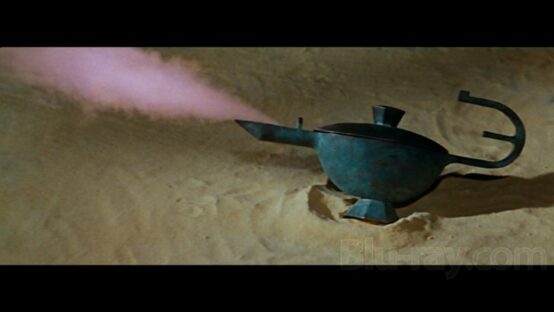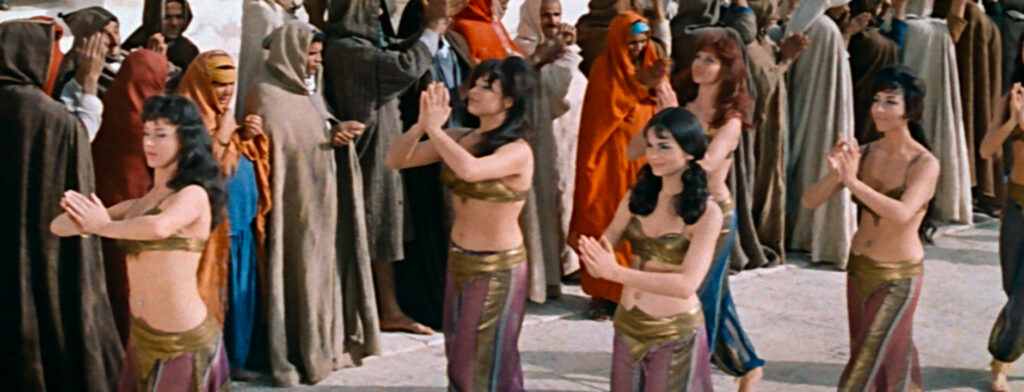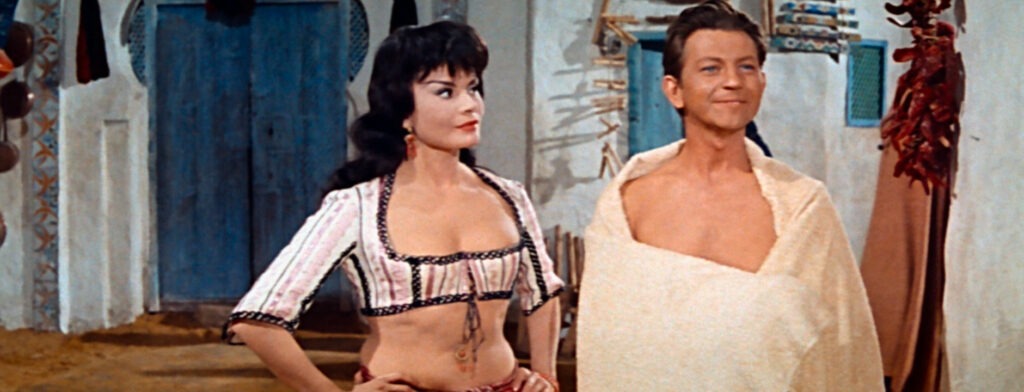After signing The Mask of the Demon, his first feature film as sole director, Mario Bava chose to humbly return to his first love by assisting American filmmakers who had come to shoot big-budget films in Italy. In the past, he thus assisted Jacques Tourneur on The Battle of Marathon, in addition to donning the hat of chief operator, as usual. It is now alongside Raoul Walsh (Esther and the King in 1960) and Henry Levin, that he will work in the shadows. The Hollywood director, who has just come out of his adaptation of Journey to the Center of the Earth with James Mason, then took on a project to transpose Persian tales and flew to Tunisia and then to Cinecittà, in order to carry out his version of Thousand and one Night. Aladdin, played by Donald O’Connor, unforgettable Cosmo Brown of Let’s sing in the rain, is a young man who lives in Baghdad with his mother. Poor, he only dreams of grandeur and splendour. One day he finds himself in possession of a mysterious lamp containing a genie who could well fulfill all his dreams. The story is known and should give rise to an adventure film in the great tradition of the genre. Bava, meanwhile, is therefore commissioned to support Levin in his task. This return to his initial post, which one could hastily qualify as a regression, turns out, for the author of The Girl Who Knew Too Much, the opportunity to get your hands on blockbusters, and to subtly instil your style and your obsessions. The collection Make My Day! by Studiocanal is enriched with a new title with this entertaining work, as classic and expected in its unfolding, as surprising by certain visual biases due to the maestro.
(© Studiocanal DVD Screenshot)
Distributed worldwide by MGM, The Wonders of Aladdin (Where The Meraviglie di Aladino) presents itself as pure family entertainment intended for the general public, of which there were hundreds between the 50s and 60s. Reviving an orientalism dear to American cinema, and this since The Thief of Baghdad by Raoul Walsh with Douglas Fairbanks, it gives pride of place to a change of scenery and a fantasy Arabia. Driven by a four-star cast where we find Michèle Mercier (future Angelica, Marquise of Angels), Aldo Fabrizi (Rome open city), the legendary Vittorio de Sica, Noëlle Adam (seen in The Prisoner de Clouzot) and the very young Mario Girotti, not yet renamed Terence Hill, Levin continues the moments of bravery at regular intervals. Between a cartoonesque escape sequence and a burlesque sword fight, the ensemble fulfills its contract thanks to the judicious use of the Scope, highlighting beautiful Tunisian natural landscapes, and a splendid Technicolor. Like its credits, against a background of drawings of minarets and dunes, the film gives pride of place to images of Epinal and navigates between naked belly dancers, crowded souks and duels in the cemetery. A kitsch and fun result which nevertheless suffers from a major problem: the presence of the nevertheless talented O’Connor, here annoying by dint of incessant histrionics. In their interview present as a bonus, Gérald Duchaussoy and Romains Vandestichele return to the incompatibility of method between the actor and Bava, responsible for directing him. Nevertheless, the result is a beautiful musical scene evoking the make ’em laugh of Stanley Donen’s masterpiece, where the actor’s physical talents are perfectly showcased. Despite its undeniable effectiveness, a feeling of a sketch film made up of interconnected segments emerges from the whole. Probable result of a complicated pre-production, which saw more than five screenwriters, including Franco Prosperi (director of The Last House on the Beach), Duccio Tessari (A butterfly with bloody wings) or even Pierre Very, author, among others of Goupi Red Hands. Names that indicate, in hollow, connections with the one who, little by little, appropriates the feature film.

(© Studiocanal DVD Screenshot)
Mario Bava, yet a simple assistant to Henry Levin, will thus insidiously take control of The thousand and One Nights. It’s funny how the film already contains a lot of elements of its own cinema, starting with its script and cast. Solima will sign two years later the scenario of The Girl Who Knew Too MuchTessari, that ofhercules the vampire slayeras for Michèle Mercier, she will be at the heart of one of the sketches of Three Faces of Fear. This contamination by the personality and the style of the filmmaker, will first be translated by the image and in particular by the use of visual effects. Although Tonino Delli Colli (Once upon a time in America, The name of the rose) is credited as chief operator, it’s a safe bet that Bava himself supervised the photography of the feature film. Passionate about special effects, he pays tribute here to his father, a pioneer in the discipline, by multiplying the games on scales (the appearance of genius, the giant chip) and also referring to figures such as Georges Méliès or Ray Harryhausen . Perceptions and illusions are at the center of his contributions. As always, faithful to his past as an art student, he sprinkles the whole thing with optical tricks, like this shot filmed through the lens of a telescope, distorting the perspectives. The psychedelic visions of the various “teleportations” complete this desire for pure abstract stupefaction. If, as Jean-Baptiste Thoret points out in his introduction, the comic passages are not very successful, the fantastic finds its place perfectly and denotes a certain taste for atmospheres saturated with colors and objects in all genres. This is the case with the sequence under the tent of the Amazons, bathed in a predominance of red, this finale which sees fireworks tinting the scenes with pink and purple, or these silhouettes of soldiers standing out against the sky. early morning blue. Monochrome tints, signature of the director who, far from sticking to simple gimmicks, will also project his themes at the heart of this project which does not however belong to him.

(© Studiocanal DVD Screenshot)
The more the story progresses, the more the film takes on the atmosphere dear to Mario Bava. The Mage’s Lair (played by Raymond Bussières), a kind of cross between a demonic cave and a mad scientist’s laboratory, materializes the filmmaker’s passion for moving architectures and Gothic atmospheres. Smoke, mummies, stalactites and skeletons intersect in a horrific environment worthy of a ghost train. It is also sleight of hand and childish tricks, between secret passages and pitfalls, which manage to save the heroes during the conclusion. The director fully assumes the return to the fairground roots of the seventh art and takes the opportunity to introduce one of the key figures of his cinema, those of the living dolls. Symbolization of characters reduced to the simple role of animated mannequins, which we find cynically in The Island of Terror or obviously the credits of Six women for the assassin, they refer here to a notion of the marvelous worthy of the tales of Hoffmann. As he did previously for The vampires, the director monopolizes the work. He injects into it a bad spirit and a black humor far removed from its postulate of a family program. The various tortures (including one based on butchered cows) and the many gags around a masochistic fakir, reinforce a morbid and enjoyable approach. Finally, the opposition between the directions of Michèle Mercier, femme fatale and sensual, and O’Connor, childish and desexualized clown, refers, according to the authors of Mario Bava: the magician of colors, to a confrontation between American puritanism specific to this kind of production, and Italian hedonism. Two visions of cinema that mingle and oppose each other at the heart of a hybrid work, as will be the following hercules the vampire slayer, led by a duo of directors quickly unbalanced as one manages, by his immediately recognizable style, to gain the upper hand. If it is not one of its major successes, The thousand and One Nights remains a significant film in the career of Mario Bava. A kind of playground where all his talent is expressed in germ.

(© Studiocanal DVD Screenshot)
As always, the Blu-Ray / DVD edition offered by Studiocanal has been enriched with exciting supplements. The essential presentation by Jean-Baptiste Thoret is accompanied by a very long bonus of over an hour in which Duchaussoy and Vandestichele discuss in detail the importance of cinema in post-war Italy and the status of series B or Z, real local hits in the same way as American blockbusters. Fascinating also the links that they weave between The thousand and One Nights and Aladdin Disney version, or between Six women for the assassin and a sequence of Let’s sing in the rain.
Available as a Blu-Ray/DVD combo from Studiocanal.
© All rights reserved. Culturopoing.com is an entirely voluntary site (Association of law 1901) and respects the copyrights, in the respect of the work of the artists whom we seek to develop. The photos visible on the site are for illustrative purposes only, not for the purpose of commercial exploitation and are not the property of Culturopoing. However, if a photograph had nevertheless escaped our control, it will be removed immediately. We count on the kindness and vigilance of each reader – anonymous, distributor, press officer, artist, photographer.
Please contact Bruno Piszczorowicz (lebornu@hotmail.com) or Olivier Rossignot (culturopoingcinema@gmail.com).
We would like to give thanks to the writer of this short article for this amazing content
Henry Levin & Mario Bava – “One Thousand and One Nights” (“The Wonders of Aladdin”) (1961)
You can view our social media profiles here , as well as additional related pages here.https://nimblespirit.com/related-pages/

